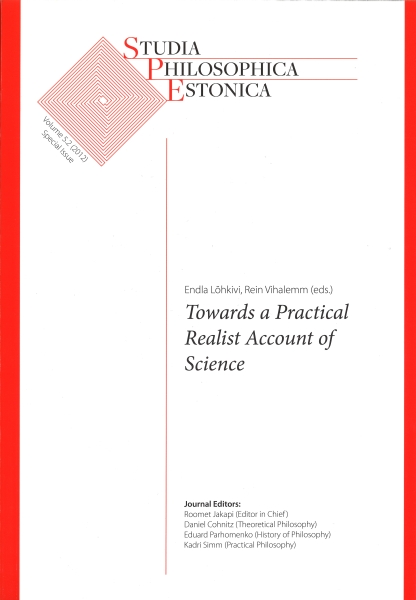Measurement Theory, Nomological Machine And Measurement Uncertainties (In Classical Physics)
DOI:
https://doi.org/10.12697/spe.2012.5.2.11Keywords:
laboratory experiment, measurement theory, measurement uncertainties, classical physics, nomological machineAbstract
Measurement is said to be the basis of exact sciences as the process of assigning numbers to matter (things or their attributes), thus making it possible to apply the mathematically formulated laws of nature to the empirical world. Mathematics and empiria are best accorded to each other in laboratory experiments which function as what Nancy Cartwright calls nomological machine: an arrangement generating (mathematical) regularities. On the basis of accounts of measurement errors and uncertainties, I will argue for two claims: 1) Both fundamental laws of physics, corresponding to ideal nomological machine, and phenomenological laws, corresponding to material nomological machine, lie, being highly idealised relative to the empirical reality; and also laboratory measurement data do not describe properties inherent to the world independently of human understanding of it. 2) Therefore the naive, representational view of measurement and experimentation should be replaced with a more pragmatic or practice-based view.
Downloads
References
Baird, D. C. (1964). Experimentation: An introduction to Measurement Theory and Experiment Design, Prentice-Hall, Englewood Cliffs, New Jersey.
Boumans, M. (2005). Measurement outside the laboratory, Philosophy of Science 72: 850-863.
Cartwright, N. (1999). The Dappled World: A Study of the Boundaries of Science, Cambridge University Press, Cambridge.
Cartwright, N. (2002a). How the Laws of Physics Lie, Oxford University Press, New York.
Cartwright, N. (2002b). Nature’s Capacities and Their Measurement, Oxford University Press, New York.
D’Agostini, G. (1999). Bayesian reasoning in high-energy physics: Principles and applications, CERN – Cervice d’information scientifique, Geneva. URL: http://cdsweb.cern.ch/record/395902?ln=en
Gooding, D. (2003). Varying the cognitive span: Experimentation, visualization, and computation, in H. Radder (ed.), The Philosophy of Scientific Experimentation, University of Pittsburgh Press, Pittsburgh, pp. 255-283.
Hacking, I. (1988). On the stability of laboratory sciences, The Journal of Philosophy 85: 507-514.
Hand, D. J. (2004). Measurement Theory and Practice: The World Through Quantification, Oxford University Press, New York.
Heidelberger, M. (2003). Theory-ladenness and scientific instruments in experimentation, in H. Radder (ed.), The Philosophy of Scientific Experimentation, University of Pittsburgh Press, Pittsburgh, pp. 138-151.
Hon, G. (1989). Towards a typology of experimental errors: An epistemological view, Studies in the History and Philosophy of Science 20: 469-504.
Isham, C. J. (1995). Lectures on Quantum Theory: Mathematical and Structural Foundations, Imperial College Press, Singapore.
Maxwell, J. C. (1965). On Faraday’s lines of force, in W. D. Niven (ed.), The Scientific Papers of James Clerk Maxwell, Vol. I,Dover, New York, pp. 155-229.
Portides, D. (2006). Abstraction, induction, and abduction in scientific modelling, in P. Flach, A. Kakas, L. Magnani and O. Ray (eds), ECAI06 Workshop on Abduction and Induction in AI and Scientific Modelling, pp. 12-16. URL: http://citeseerx.ist.psu.edu/viewdoc/download?doi=10.1.1.99.8993&rep=rep1&type=pdf
Portides, D. (2009). Theories, models and scientific representation. Paper presented at EPSA09–2nd Conference of the European Philosophy of Science Association, Amsterdam.
Radder, H. (2003). Technology and theory in experimental science, in H. Radder (ed.), The Philosophy of Scientific Experimentation, University of Pittsburgh Press, Pittsburgh, pp. 152-173.
Riordan, S. (2011). The first determination of the kilogram, 1790-1799: A fresh look at the theoretical-observational divide. Paper presented at EPSA11–3rd Conference of the European Philosophy of Science Association, Athens.
Rothbart, D. (2007). Philosophical Instruments: Minds and Tools at Work, University of Illinois Press, Urbana and Chicago.
Skoog, D. A. and Leary, J. J. (1992). Principles of Instrumental Analysis, Harcourt Brace Jovanovich College Publisher, Fort Worth.
Suppes, P. and Zinnes, J. L. (1962). Basic measurement theory. Stanford University. URL: http://suppes-corpus.stanford.edu/techreports/IMSSS_45.pdf
Tal, E. (2011a). Howaccurateis thestandard second?, Philosophy of Science. URL:http://individual.utoronto.ca/eran_tal/papers/Tal_How_Accurate_is_the_Standard_Second_PSA.pdf
Tal, E. (2011b). Systematic error and the problem of quantity individuation. Paper presented at the workshop Error in the Sciences, Leiden; an abridged version of a chapter of the PhD thesis Tal, E. (2012) The Epistemology of Measurement: A Model-Based Account, University of Toronto. URL: http://www.lorentzcenter.nl/lc/web/2011/460/presentations/index.php3?wsid=460&type=presentations
Vihalemm, R. (ed.) (1979). Methodology of Science [in Estonian] = Teaduse metodoloogia, Eesti Raamat, Tallinn.
Vihalemm, R. (1989). On methodologically equating chemistry with physics [in Estonian] = Keemia metodoloogilisest samastamisest füüsikaga, Teaduslugu ja nüüdisaeg IV: 30-40.
Woodward, J. (1989). Data and phenomena, Synthese 79: 393-472.

